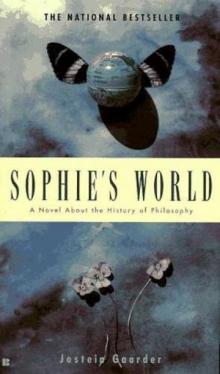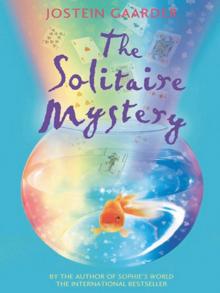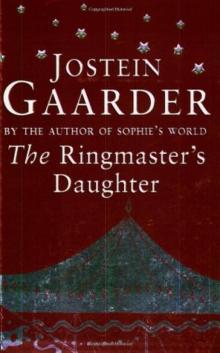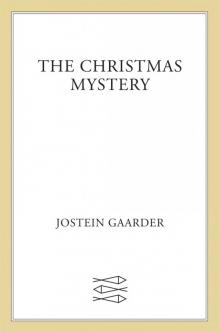- Home
- Jostein Gaarder
Sophie's World: A Novel About the History of Philosophy Page 18
Sophie's World: A Novel About the History of Philosophy Read online
Page 18
The footsteps passed her on their way up the aisle and she saw a figure dressed in a brown monk’s habit. Sophie could have sworn it was a monk right out of the Middle Ages.
She was nervous, but not scared out of her wits. In front of the altar the monk turned in a half-circle and then climbed up into the pulpit. He leaned over the edge, looked down at Sophie, and addressed her in Latin:
“Gloria Patri, et Filio, et Spiritui Sancto. Sicut erat in principio, et nunc, et semper et in saecula saeculorum. Amen.”
“Talk sense, silly!” Sophie burst out.
Her voice resounded all around the old stone church.
Although she realized that the monk had to be Alberto Knox, she regretted her outburst in this venerable place of worship. But she had been nervous, and when you’re nervous its comforting to break all taboos.
“Shhh!” Alberto held up one hand as priests do when they want the congregation to be seated.
“Middle Ages began at four,” he said.
“Middle Ages began at four?” asked Sophie, feeling stupid but no longer nervous.
“About four o’clock, yes. And then it was five and six and seven. But it was as if time stood still. And it got to be eight and nine and ten. But it was still the Middle Ages, you see. Time to get up to a new day, you may think. Yes, I see what you mean. But it is still Sunday, one long endless row of Sundays. And it got to be eleven and twelve and thirteen. This was the period we call the High Gothic, when the great cathedrals of Europe were built. And then, some time around fourteen hours, at two in the afternoon, a cock crowed—and the Middle Ages began to ebb away.”
“So the Middle Ages lasted for ten hours then,” said Sophie. Alberto thrust his head forward out of the brown monk’s cowl and surveyed his congregation, which consisted of a fourteen-year-old girl.
“If each hour was a hundred years, yes. We can pretend that Jesus was born at midnight. Paul began his missionary journeys just before half past one in the morning and died in Rome a quarter of an hour later. Around three in the morning the Christian church was more or less banned, but by A.D. 313 it was an accepted religion in the Roman Empire. That was in the reign of the Emperor Constantine. The holy emperor himself was first baptized on his deathbed many years later. From the year 380 Christianity was the official religion throughout the entire Roman Empire.”
“Didn’t the Roman Empire fall?”
“It was just beginning to crumble. We are standing before one of the greatest changes in the history of culture. Rome in the fourth century was being threatened both by barbarians pressing in from the north and by disintegration from within. In A.D. 330 Constantine the Great moved the capital of the Empire from Rome to Constantinople, the city he had founded at the approach to the Black Sea. Many people considered the new city the “second Rome.” In 395 the Roman Empire was divided in two—a Western Empire with Rome as its center, and an Eastern Empire with the new city of Constantinople as its capital. Rome was plundered by barbarians in 410, and in 476 the whole of the Western Empire was destroyed. The Eastern Empire continued to exist as a state right up until 1453 when the Turks conquered Constantinople.”
“And its name got changed to Istanbul?”
“That’s right! Istanbul is its latest name. Another date we should notice is 529. That was the year when the church closed Plato’s Academy in Athens. In the same year, the Benedictine order, the first of the great monastic orders, was founded. The year 529 thus became a symbol of the way the Christian Church put the lid on Greek philosophy. From then on, monasteries had the monopoly of education, reflection, and meditation. The clock was ticking toward half past five ...”
Sophie saw what Alberto meant by all these times. Midnight was 0, one o’clock was 100 years after Christ, six o’clock was 600 years after Christ, and 14 hours was 1,400 years after Christ...
Alberto continued: “The Middle Ages actually means the period between two other epochs. The expression arose during the Renaissance. The Dark Ages, as they were also called, were seen then as one interminable thousand-year-long night which had settled over Europe between antiquity and the Renaissance. The word ‘medieval’ is used negatively nowadays about anything that is over-authoritative and inflexible. But many historians now consider the Middle Ages to have been a thousand-year period of germination and growth. The school system, for instance, was developed in the Middle Ages. The first convent schools were opened quite early on in the period, and cathedral schools followed in the twelfth century. Around the year 1200 the first universities were founded, and the subjects to be studied were grouped into various ‘faculties,’ just as they are today.”
“A thousand years is a really long time.”
“Yes, but Christianity took time to reach the masses. Moreover, in the course of the Middle Ages the various nation-states established themselves, with cities and citizens, folk music and folktales. What would fairy tales and folk songs have been without the Middle Ages? What would Europe have been, even? A Roman province, perhaps. Yet the resonance in such names as England, France, or Germany is the very same boundless deep we call the Middle Ages. There are many shining fish swimming around in those depths, although we do not always catch sight of them. Snorri lived in the Middle Ages. So did Saint Olaf and Charlemagne, to say nothing of Romeo and Juliet, Joan of Arc, Ivanhoe, the Pied Piper of Hamelin, and many mighty princes and majestic kings, chivalrous knights and fair damsels, anonymous stained-glass window makers and ingenious organ builders. And I haven’t even mentioned friars, crusaders, or witches.”
“You haven’t mentioned the clergy, either.”
“Correct. Christianity didn’t come to Norway, by the way, until the eleventh century. It would be an exaggeration to say that the Nordic countries converted to Christianity at one fell swoop. Ancient heathen beliefs persisted under the surface of Christianity, and many of these pre-Christian elements became integrated with Christianity. In Scandinavian Christmas celebrations, for example, Christian and Old Norse customs are wedded even to this day. And here the old saying applies, that married folk grow to resemble each other. Yuletide cookies, Yuletide piglets, and Yuletide ale begin to resemble the Three Wise Men from the Orient and the manger in Bethlehem. But without doubt, Christianity gradually became the predominant philosophy of life. Therefore we usually speak of the Middle Ages as being a unifying force of Christian culture.”
“So it wasn’t all gloom, then?”
“The first centuries after the year 400 really were a cultural decline. The Roman period had been a high culture, with big cities that had sewers, public baths, and libraries, not to mention proud architecture. In the early centuries of the Middle Ages this entire culture crumbled. So did its trade and economy. In the Middle Ages people returned to payment in kind and bartering. The economy was now characterized by feudalism, which meant that a few powerful nobles owned the land, which the serfs had to toil on in order to live. The population also declined steeply in the first centuries. Rome had over a million inhabitants in antiquity. But by 600, the population of the old Roman capital had fallen to 40,000, a mere fraction of what it had been. Thus a relatively small population was left to wander among what remained of the majestic edifices of the city’s former glory. When they needed building materials, there were plenty of ruins to supply them. This is naturally a source of great sorrow to present-day archeologists, who would rather have seen medieval man leave the ancient monuments untouched.”
“It’s easy to know better after the fact.”
“From a political point of view, the Roman period was already over by the end of the fourth century. However, the Bishop of Rome became the supreme head of the Roman Catholic Church. He was given the title ‘Pope’—in Latin ‘papa,’ which means what it says— and gradually became looked upon as Christ’s deputy on earth. Rome was thus the Christian capital throughout most of the medieval period. But as the kings and bishops of the new nation-states became more and more powerful, some of them were bold enough to stand up
to the might of the church.”
“You said the church closed Plato’s Academy in Athens. Does that mean that all the Greek philosophers were forgotten?”
“Not entirely. Some of the writings of Aristotle and Plato were known. But the old Roman Empire was gradually divided into three different cultures. In Western Europe we had a Latinized Christian culture with Rome as its capital. In Eastern Europe we had a Greek Christian culture with Constantinople as its capital. This city began to be called by its Greek name, Byzantium. We therefore speak of the Byzantine Middle Ages as opposed to the Roman Catholic Middle Ages. However, North Africa and the Middle East had also been part of the Roman Empire. This area developed during the Middle Ages into an Arabic-speaking Muslim culture. After the death of Muhammad in 632, both the Middle East and North Africa were won over to Islam. Shortly thereafter, Spain also became part of the world of Islamic culture. Islam adopted Mecca, Medina, Jerusalem, and Bagdad as holy cities. From the point of view of cultural history, it is interesting to note that the Arabs also took over the ancient Hellenistic city of Alexandria. Thus much of the old Greek science was inherited by the Arabs. All through the Middle Ages, the Arabs were predominant hi sciences such as mathematics, chemistry, astronomy, and medicine. Nowadays we still use Arabic figures. In a number of areas Arabic culture was superior to Christian culture.”
“I wanted to know what happened to Greek philosophy.”
“Can you imagine a broad river that divides for a while into three different streams before it once again becomes one great wide river?”
“Yes.”
“Then you can also see how the Greco-Roman culture was divided, but survived through the three cultures: the Roman Catholic in the west, the Byzantine in the east, and the Arabic in the south. Although it’s greatly oversimplified, we could say that Neoplatonism was handed down in the west, Plato in the east, and Aristotle to the Arabs in the south. But there was also something of them all in all three streams. The point is that at the end of the Middle Ages, all three streams came together in Northern Italy. The Arabic influence came from the Arabs in Spain, the Greek influence from Greece and the Byzantine Empire. And now we see the beginning of the Renaissance, the ‘rebirth’ of antique culture. In one sense, antique culture had survived the Dark Ages.”
“I see.”
“But let us not anticipate the course of events. We mast first talk a little about medieval philosophy. I shall not speak from this pulpit any more. I’m coming down.”
Sophie’s eyes were heavy from too little sleep. When she saw the strange monk descending from the pulpit of St. Mary’s Church, she felt as if she were dreaming.
Alberto walked toward the altar rail. He looked up at the altar with its ancient crucifix, then he walked slowly toward Sophie. He sat down beside her on the bench of the pew.
It was a strange feeling, being so close to him. Under his cowl Sophie saw a pair of deep brown eyes. They belonged to a middle-aged man with dark hair and a little pointed beard. Who are you, she wondered. Why have you turned my life upside down?
“We shall become better acquainted by and by,” he said, as if he had read her thoughts.
As they sat there together, with the light that filtered into the church through the stained-glass windows becoming sharper and sharper, Alberto Knox began to talk about medieval philosophy.
“The medieval philosophers took it almost for granted that Christianity was true,” he began. “The question was whether we must simply believe the Christian revelation or whether we can approach the Christian truths with the help of reason. What was the relationship between the Greek philosophers and what the Bible said? Was there a contradiction between the Bible and reason, or were belief and knowledge compatible? Almost all medieval philosophy centered on this one question.”
Sophie nodded impatiently. She had been through this in her religion class.
“We shall see how the two most prominent medieval philosophers dealt with this question, and we might as well begin with St. Augustine, who lived from 354 to 430. In this one person’s life we can observe the actual transition from late antiquity to the Early Middle Ages. Augustine was born in the little town of Tagaste in North Africa. At the age of sixteen he went to Carthage to study. Later he traveled to Rome and Milan, and lived the last years of his life in the town of Hippo, a few miles west of Carthage. However, he was not a Christian all his life. Augustine examined several different religions and philosophies before he became a Christian.”
“Could you give some examples?”
“For a time he was a Manichaean. The Manichaeans were a religious sect that was extremely characteristic of late antiquity. Their doctrine was half religion and half philosophy, asserting that the world consisted of a dualism of good and evil, light and darkness, spirit and matter. With his spirit, mankind could rise above the world of matter and thus prepare for the salvation of his soul. But this sharp division between good and evil gave the young Augustine no peace of mind. He was completely preoccupied with what we like to call the ‘problem of evil.’ By this we mean the question of where evil comes from. For a time he was influenced by Stoic philosophy, and according to the Stoics, there was no sharp division between good and evil. However, his principal leanings were toward the other significant philosophy of late antiquity, Neoplatonism. Here he came across the idea that all existence is divine in nature.”
“So he became a Neoplatonic bishop?”
“Yes, you could say that. He became a Christian first, but the Christianity of St. Augustine is largely influenced by Platonic ideas. And therefore, Sophie, therefore you have to understand that there is no dramatic break with Greek philosophy the minute we enter the Christian Middle Ages. Much of Greek philosophy was carried over to the new age through Fathers of the Church like St. Augustine.”
“Do you mean that St. Augustine was half Christian and half Neoplatonist?”
“He himself believed he was a hundred-percent Christian although he saw no real contradiction between Christianity and the philosophy of Plato. For him, the similarity between Plato and the Christian doctrine was so apparent that he thought Plato must have had knowledge of the Old Testament. This, of course, is highly improbable. Let us rather say that it was St. Augustine who ‘christianized’ Plato.”
“So he didn’t turn his back on everything that had to do with philosophy when he started believing in Christianity?”
“No, but he pointed out that there are limits to how far reason can get you in religious questions. Christianity is a divine mystery that we can only perceive through faith. But if we believe in Christianity, God will ‘illuminate’ the soul so that we experience a sort of supernatural knowledge of God. St. Augustine had felt within himself that there was a limit to how far philosophy could go. Not before he became a Christian did he find peace in his own soul. ‘Our heart is not quiet until it rests in Thee,’ he writes.”
“I don’t quite understand how Plato’s ideas could go together with Christianity,” Sophie objected. “What about the eternal ideas?”
“Well, St. Augustine certainly maintains that God created the world out of the void, and that was a Biblical idea. The Greeks preferred the idea that the world had always existed. But St. Augustine believed that before God created the world, the ‘ideas’ were in the Divine mind. So he located the Platonic ideas in God and in that way preserved the Platonic view of eternal ideas.”
“That was smart.”
“But it indicates how not only St. Augustine but many of the other Church Fathers bent over backward to bring Greek and Jewish thought together. In a sense they were of two cultures. Augustine also inclined to Neoplatonism in his view of evil. He believed, like Plotinus, that evil is the ‘absence of God.’ Evil has no independent existence, it is something that is not, for God’s creation is in fact only good. Evil comes from mankind’s disobedience, Augustine believed. Or, in his own words, ‘The good will is God’s work; the evil will is the falling away from God’s work.’ “<
br />
“Did he also believe that man has a divine soul?”
“Yes and no. St. Augustine maintained that there is an insurmountable barrier between God and the world. In this he stands firmly on Biblical ground, rejecting the doctrine of Plotinus that everything is one. But he nevertheless emphasizes that man is a spiritual being. He has a material body—which belongs to the physical world which ‘moth and rust doth corrupt’—but he also has a soul which can know God.”
“What happens to the soul when we die?”
“According to St. Augustine, the entire human race was lost after the Fall of Man. But God nevertheless decided that certain people should be saved from perdition.”
“In that case, God could just as well have decided that everybody should be saved.”
“As far as that goes, St. Augustine denied that man has any right to criticize God, referring to Paul’s Epistle to the Romans: ‘O Man, who art thou that replies! against God? Shall the thing formed say to him that formed it; why hast thou made me thus? or Hath not the potter power over the clay, of the same lump to make one vessel unto honor and another unto dishonor?’ “
“So God sits up in his Heaven playing with people? And as soon as he is dissatisfied with one of his creations, he just throws it away.”
“St. Augustine’s point was that no man deserves God’s redemption. And yet God has chosen some to be saved from damnation, so for him there was nothing secret about who will be saved and who damned. It is preordained. We are entirely at his mercy.”
“So in a way, he returned to the old belief in fate.”
“Perhaps. But St. Augustine did not renounce man’s responsibility for his own life. He taught that we must live in awareness of being among the chosen. He did not deny that we have free will. But God has ‘foreseen’ how we will live.”
“Isn’t that rather unfair?” asked Sophie. “Socrates said that we all had the same chances because we all had the same common sense. But St. Augustine divides people into two groups. One group gets saved and the other gets damned.”

 Sophie's World: A Novel About the History of Philosophy
Sophie's World: A Novel About the History of Philosophy The Solitaire Mystery
The Solitaire Mystery The Ringmaster's Daughter
The Ringmaster's Daughter The Christmas Mystery
The Christmas Mystery Sophie's World
Sophie's World